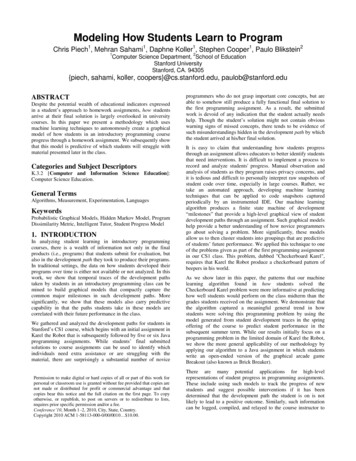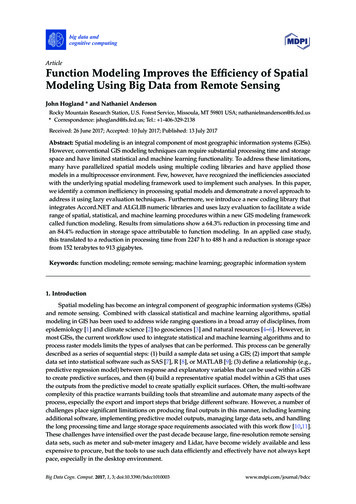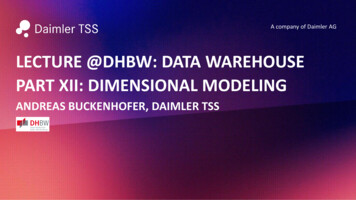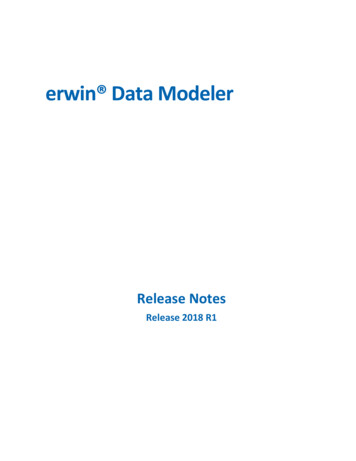
Transcription
Modeling How Students Learn to ProgramChris Piech1, Mehran Sahami1, Daphne Koller1, Stephen Cooper1, Paulo Blikstein212Computer Science Department, School of EducationStanford UniversityStanford, CA. 94305{piech, sahami, koller, coopers}@cs.stanford.edu, paulob@stanford.eduABSTRACTDespite the potential wealth of educational indicators expressedin a student’s approach to homework assignments, how studentsarrive at their final solution is largely overlooked in universitycourses. In this paper we present a methodology which usesmachine learning techniques to autonomously create a graphicalmodel of how students in an introductory programming courseprogress through a homework assignment. We subsequently showthat this model is predictive of which students will struggle withmaterial presented later in the class.Categories and Subject DescriptorsK.3.2 [Computer and Information Science Education]:Computer Science Education.General TermsAlgorithms, Measurement, Experimentation, LanguagesKeywordsProbabilistic Graphical Models, Hidden Markov Model, ProgramDissimilarity Metric, Intelligent Tutor, Student Progress Model1. INTRODUCTIONIn analyzing student learning in introductory programmingcourses, there is a wealth of information not only in the finalproducts (i.e., programs) that students submit for evaluation, butalso in the development path they took to produce their programs.In traditional settings, the data on how students developed theirprograms over time is either not available or not analyzed. In thiswork, we show that temporal traces of the development pathstaken by students in an introductory programming class can bemined to build graphical models that compactly capture thecommon major milestones in such development paths. Moresignificantly, we show that these models also carry predictivecapability in that the paths students take in these models arecorrelated with their future performance in the class.We gathered and analyzed the development paths for students inStanford’s CS1 course, which begins with an initial assignment inKarel the Robot that is subsequently followed by five or six Javaprogramming assignments. While students’ final submittedsolutions to course assignments can be used to identify whichindividuals need extra assistance or are struggling with thematerial, there are surprisingly a substantial number of novicePermission to make digital or hard copies of all or part of this work forpersonal or classroom use is granted without fee provided that copies arenot made or distributed for profit or commercial advantage and thatcopies bear this notice and the full citation on the first page. To copyotherwise, or republish, to post on servers or to redistribute to lists,requires prior specific permission and/or a fee.Conference’10, Month 1–2, 2010, City, State, Country.Copyright 2010 ACM 1-58113-000-0/00/0010 10.00.programmers who do not grasp important core concepts, but areable to somehow still produce a fully functional final solution tothe first programming assignment. As a result, the submittedwork is devoid of any indication that the student actually needshelp. Though the student’s solution might not contain obviouswarning signs of missed concepts, there tends to be evidence ofsuch misunderstandings hidden in the development path by whichthe student arrived at his/her final solution.It is easy to claim that understanding how students progressthrough an assignment allows educators to better identify studentsthat need interventions. It is difficult to implement a process torecord and analyze students' progress. Manual observation andanalysis of students as they program raises privacy concerns, andit is tedious and difficult to personally interpret raw snapshots ofstudent code over time, especially in large courses. Rather, wetake an automated approach, developing machine learningtechniques that can be applied to code snapshots capturedperiodically by an instrumented IDE. Our machine learningalgorithm produces a finite state machine of development―milestones‖ that provide a high-level graphical view of studentdevelopment paths through an assignment. Such graphical modelshelp provide a better understanding of how novice programmersgo about solving a problem. More significantly, these modelsallow us to then cluster students into groupings that are predictiveof students’ future performance. We applied this technique to oneof the problems given as part of the first programming assignmentin our CS1 class. This problem, dubbed "Checkerboard Karel",requires that Karel the Robot produce a checkerboard pattern ofbeepers in his world.As we show later in this paper, the patterns that our machinelearning algorithm found in how students solved theCheckerboard Karel problem were more informative at predictinghow well students would perform on the class midterm than thegrades students received on the assignment. We demonstrate thatthe algorithm captured a meaningful general trend in howstudents were solving this programming problem by using themodel generated from student development traces in the springoffering of the course to predict student performance in thesubsequent summer term. While our results initially focus on aprogramming problem in the limited domain of Karel the Robot,we show the more general applicability of our methodology byapplying our algorithm to a Java assignment in which studentswrite an open-ended version of the graphical arcade gameBreakout (also known as Brick Breaker).There are many potential applications for high-levelrepresentations of student progress in programming assignments.These include using such models to track the progress of newstudents and suggest possible interventions if it has beendetermined that the development path the student is on is notlikely to lead to a positive outcome. Similarly, such informationcan be logged, compiled, and relayed to the course instructor to
help provide a more accurate picture of the concepts in the coursewith which the students are truly struggling.As mentioned previously, our machine learning algorithmautonomously produces a probabilistic finite state machinerepresentation of how students in the class traversed throughvarious ―milestones‖ in the Karel assignment. The patterns thatthe machine learning algorithm finds provide insight into whatprogramming motifs are common for students who wouldstruggle later on in the course, and also provides a visualization ofhow the class as a whole approached the Karel assignment.The main results presented in this paper are: the development of machine learning methods that buildmodels of high-level student development pathways inprogramming assignments, the application of these methods to a large set of student tracedata by which the algorithm is successfully able toautonomously extract novel features of a student’s progressover the course of an assignment, and the use of these features to predict students’ futureperformance in the class as measured by their midterm grades.The novelty of this work stems from: the collection of a unique dataset of student development tracedata, the presentation of an application of unsupervised machinelearning concepts to a new domain, and the potential pedagogical insights that can be gained from themodel generated by the machine learning algorithm. Thisresearch is particularly pertinent to large lecture-based classesand online courses.2. RELATED WORKThis research expands upon previous attempts to find a symbolicrepresentation of student progress. Reiser [19] made the argumentthat development of an autonomous system that could understanda student’s current state as the student solves a programmingproblem would have profound educational implications.Spohrer and Soloway [27] tried to represent how students learnedto program through an investigation of the bugs in the students'code. Students' programs were examined as soon as their codecleanly compiled (and was thus devoid of syntax errors), and theirbugs identified and categorized. The decision to analyze studentbugs as soon as their code compiled cleanly was reasonable,given that it would not have been possible to analyze allintermediate versions of students' code as the analysis was doneby hand. Their strategy was limited in that it would not be usefulfor trying to analyze the students who solve a problem one part ata time (those initial clean compiles would not include much of theoverall solution), and they did not observe the progression ofstudent code development throughout the assignment.There has been work on studying students' progress at a morefine-grained level, by focusing on specific programming languageconstructs. These constructs include variables [23], conditionals[10], looping [25], and methods [12]. The assumption in many ofthese studies is that student progress can be understood throughdifficulties with specific programming constructs.Many researchers have attempted to determine students' mentalmodels of computers and computing (see [13] as an interestingearly example), using various qualitative techniques such asphenomenography [1, 3]. Because such studies tend to be indepth and time-consuming, the number of participants tends to bequite small.The task of constructing a dynamic student model has had aresurgence with the introduction of artificial intelligencealgorithms. In a paper on coached problem solving usingBayesian networks, Conati [5] demonstrated the potential ofusing an expert crafted graphical model for tutoring studentslearning physics. However, in Conati’s work, as in manyinstances of supervised learning applied to constructing adynamic student model, it is noted that supervised learning islimited by the laborious process of expert graphical modelconstruction and the lack of transferability of these expertgenerated models from one program to another.Recent research has used automated log analysis analyze studentprograms, especially trying to distinguish novices and experts.Blikstein [30, 31, 32] used thousands of time-stamped snapshotsof students’ code and found markedly diverse strategies betweenexperienced and novice programmers. By mining snapshots fromcode repositories, Berland and Martin [29] found that novicestudents' developed successful program code by following one oftwo progressions: planner and tinkerer. Planners found success bycarefully structuring programs over time, and tinkerers foundsuccess by accreting programs over time. Students were generallyunsuccessful if they didn't follow one of those paths.This common limitation in the state of the art for dynamic studentmodeling highlights the need for an unsupervised (i.e., fullyautonomous) approach. However, despite the apparent utility of afully autonomous system, little work has been done to applyunsupervised learning algorithms.3. DATA COLLECTIONOver the summer of 2010 we modified the IntegratedDevelopment Environment (IDE)—Eclipse—used by students inStanford’s CS1 course so that it would log snapshots, a completeversion of the student’s program at that point in time, every timea student compiles a project (which the students must do beforethey can run their program) and commits that snapshot to a localgit repository. When the student submits the final version of theirassignment, they can elect (opt-in) to also submit the full gitrepository of their progress (i.e., code snapshots) in developingtheir solution. For this investigation we analyzed data from twoassignments, Checkerboard Karel and Breakout, described below.Checkerboard Karel: Karel the Robot is used in the first week ofCS1 to teach students basic program flow and decomposition.The particular variant of the Karel programming language we useis a Java-based language [20], which most notably does notinclude variables or parameters. In this assignment the studentswere asked to make Karel the Robot place beepers in acheckerboard fashion with an alternating pattern of beepers andno beepers, filling up the whole world. The full solution needs towork on any sized Karel world. It is hard to get an algorithm towork on worlds with an odd number of columns, particularly so ifthere is only one column. At this point in the course most studentsstruggle with understanding nested while loops and how toidentify pre and post conditions for their methods and loops.Breakout: This assignment asks students to implement a classicarcade game [16]. The students need to write an animation loop,incorporate mouse events and keep track of game state. It is the
third assignment given in CS1 and the first large programmingproject written in Java using the ACM graphics library [28].We collected repositories from N 370 Karel assignments (238from spring 2011 and 132 from summer 2011). For each studentwe had on average 159 snapshots of them programmingcheckerboard Karel with a standard deviation of 82 snapshots.Each snapshot was time-stamped and could be run through asimulator to record errors or to test functionality. We alsoanalyzed Breakout repositories from N 205 students all ofwhich were from winter 2011 where the snapshot count perstudent had a mean of 269, and a variance of 153. To protect theprivacy of our students we removed students’ names from allsnapshots. We chose to capture snapshots when the studentcompiled/saved as we thought this would be the bestinterpretation of a ―unit‖ of work.4. DATA ANALYSIS4.1 Program Distance MetricFor the machine learning algorithm to build a model of howstudents progress through an assignment, it needs to compare twoprograms against one other and determine the extent to which thetwo pieces of code should be considered similar. Specifically, thealgorithm used requires that we calculate a real number thataccurately reflects the degree to which two programs aredissimilar. We considered three algorithms for calculatingdissimilarity:1. Bag of Words Difference: We built histograms of the differentkey words used in a program and used the Euclidean distancebetween two histograms as a naïve measure of the dissimilarity.This is similar to distance measures of text commonly used ininformation retrieval systems [22].2. Application Program Interface (API) Call Dissimilarity: Weran each program with standard inputs and recorded the resultingsequence of API calls. We used Needleman-Wunsch global DNAalignment [14] to measure the difference between the lists of APIcalls generated by the two programs. Intuitively, we think of thesequence of API calls made in the program to be the "DNA" ofthat program, and we are comparing the DNA of two programs todetermine their dissimilarity. We note that we modified theNeedleman-Wunsch algorithm to allow for gap penalties whichvaried based on the API call that was matched with the gap.API calls are a particularly good representation of Karel programsbecause the Karel programs do not store variables—and as aresult an assignment’s entire functionality is expressed in terms ofsimple API calls (e.g., turnLeft, move, etc,). This metric is moredifficult to implement for full Java programs. For example,Breakout makes graphics API calls but with parameters thatchange the nature of the API call. This makes it more difficult tocreate a single token that fully captures the effect of any call.3. Abstract Syntax Tree (AST) Change Severity: We built ASTrepresentations of both programs and calculated the summation ofEvolizer abstract change severities as described by Gall et al [9].The Evolizer change severity score calculates the minimumnumber of rotations, insertions and deletions that need to beapplied to the AST of one program to transform it into the AST ofanother program. It uses an analysis of each syntax tree to weighthow significantly an edit changes the AST.All of our dissimilarity metrics were normalized by sum of thedistances between the programs and the "starter" code (the smallamount of code students may have been given initially as part oftheir assignment framework). To evaluate each metric we had agroup of five advanced computer science students with teachingexperience (whom we subsequently refer to as "experts") label aset of snapshot pairs as either similar or different and measuredhow well the distance metrics could replicate the expert labels.Table 1. Distance Metric EvaluationMetric1. Bag of Words2. API Calls3. AST ChangePercent Accuracy55%86%75%The experts were asked to assess similarity based on a rubrichaving them identify major and minor stylistic and functionaldifferences between pairs of programs. We selected 90 pairs ofprograms, capturing a spectrum of similar, dissimilar and slightlysimilar code. For the checkerboard Karel assignment the API CallDissimilarity performed best (see Table 1) with an accuracy of86% (relative to chance). The set of pairs mislabeledby the Bag of Words and AST Change Severity largelyoverlapped with the set of pairs where the human expertsdisagreed.While the distance metrics seemed to accurately measure thedissimilarity between code snapshots, they are biased towardsassigning low dissimilarity score to snapshots from the samestudent. To account for this bias, we modified all of ouralgorithms to never use the dissimilarity value computed fromtwo snapshots that originated from the same student.The distance metric used to build our model was a weighted sumof the AST Change metric and a set of API Dissimilarity scores(each generated by running the programs with a different inputworld). We built a Support Vector Machine [6] trained to classifythe human labeled data using the different distance metrics asfeatures. The values used to weight the distance measures in ourcomposite dissimilarity score were the weights assigned to eachdistance measure by the Support Vector Machine.4.2 Modeling ProgressThe first step in our student modeling process was to learn a highlevel representation of how each student progressed through thecheckerboard Karel assignment. To learn this representation wemodeled a student’s progress as a Hidden Markov Model (HMM)[17]. The HMM we used (see Figure 1) proposes that at eachsnapshot, a student is in a "high-level milestone," referred to as astate. While we cannot directly observe the state (it is a latentvariable), we can observe the source code of the snapshot, whichis a noisy sensor of the latent variable. Example states could be―the student has just started‖ or ―the student has gotten Karel tochecker all worlds except for worlds with a single column.‖ Notethat these states need not be explicitly labeled in the model. Theyare autonomously induced by our learning algorithm given thestudent trace data provided. The HMM is parameterized by theprobabilities of a student going from one state to another and theprobability that a given snapshot came from a particularmilestone. A HMM is a relevant model of student progressbecause programming is generally an incremental process. Themilestone where a student is at a given time is not independent ofthe milestone that he/she was at in the previous time step. TheHMM explicitly captures this dependency.Modeling student progress as a HMM makes the over-simplifyingMarkov assumption that the future state of a student is
independent of past states that the student was in given that weknow the individual’s current state. While this assumption is notentirely correct (a student’s current state alone does not capturewhat they learned from experience), this statistical simplificationis still useful for finding patterns and making predictions whilemaintaining algorithmic tractability. Similarly this HMM assumesa relatively constant rate of change between observations.Realizing that a commit/save is a coarse representation of a unitof work, and that there are notably different patterns in commitrates among different students, we smooth out the difference incommit rates using dynamic time warping [18] to better match theunderlying assumptions of the model.Learning a HMM is identical to learning a finite state machine(FSM) of how students transition through the high-levelmilestones. Each state from the HMM becomes a node in theFSM and the weight of a directed edge from one node to anotherprovides the probability of transitioning from one state to thenext.and evenly over time) and clustered the sample using K-Medioids[11]. K-Medioids is a variation of K-Means clustering wherecentroids are represented by the median code snapshot instead ofbeing a numerical average of the set of examples in the cluster, asit is not possible to construct a synthetic "average" code snapshot.In a similar vein to the Buckshot algorithm [7], we initialized KMediods using cluster labels from Hierarchical AgglomerativeClustering.Once we had established the set of states (i.e., milestones) of anassignment, we used an EM algorithm to simultaneously computeboth the transition and emission probabilities in the state diagram.To initialize the algorithm, we calculate the probabilities underthe assumption that all state variables are independent of oneanother. In the expectation step of EM, the best guess at theprogress of a student through the HMM was made using theforward-backwards algorithm [17]. The EM algorithm resulted ina probabilistic assignment to the state variables for each studentat each point in time, and also provided estimates for parametersto the HMM reflecting the state diagram induced from data overall students in the class.4.3 Finding Patterns in PathsFigure 1. The program's Hidden Markov Model of statetransitions for a given student. The node "codet" denotes thecode snapshot of the student at time t, and the node "statet"denotes the high-level milestone that the student is in at time t.N is the number of snapshots for the student.In order to learn the HMM we must identify three variables:1. The finite set of high-levelor milestonesthat a student could be in. A state is defined by a set ofsnapshots where all the snapshots in the set came from thesame milestone.2. The transition probability,, of beingin a state given the state you were in in the previous unit oftime.3. The emission probability,, of seeing aspecific snapshot given that you are in a particular state. Tocalculate the emission probability we interpreted each of thestates as emitting snapshots with normally distributeddissimilarities. In other words, given the dissimilarity betweena particular snapshot of student code and a state’s"representative" snapshot, we can calculate the probabilitythat the student snapshot came from a given state using aNormal distribution based on the dissimilarity.While it would be possible to learn all three variables in theHMM in a single Expectation Maximization (EM) algorithm [8],for computational ease the process is divided into two phases:learning the assignment states and learning the transition andemission probabilities.To compute the set of high-level states (the different milestonesof the assignment), we sampled two thousand snapshots chosenfrom the Karel training dataset (distributed evenly over studentsThe final step in our algorithm was to find patterns in how thestudents were transitioning through the HMM. To find thesepatterns we clustered the paths that students took through theHMM. To cluster the paths we ran the K-Means algorithm overthe space of HMM, using a method developed by Smyth [24]. Foreach student we constructed a HMM to represent their statetransitions—these per student models also incorporated priorprobabilities based on the HMM developed using data from thewhole class. We measured dissimilarity between two students asthe symmetric (i.e., averaged) probability that student A’strajectory could be produced by student B’s HMM and vice versa.Using this distance measure, we then clustered all the studentpaths to create groupings of students based on the characteristicsof their entire development path for the assignment.5. RESULTSClustering on a sample of 2000 random snapshots from thetraining set returned a group of well-defined snapshot clusters(see Figure 2). The value of K that maximized silhouette score (ameasure of how natural the clustering was) was 26 clusters. Avisual inspection of these clusters confirmed that snapshots whichclustered together were functionally similar pieces of code.When we repeated this process with a different set of randomsnapshots, 25 of the 27 clusters were the same, indicating that theresults were quite stable and that the patterns found were not dueto chance. Moreover, a manual examination of the states of theinduced HMM revealed that they made intuitive sense. The classwide state machine showed that there were several ―sink‖states—milestones where the students clearly had seriousfunctional problems. Interestingly, once a student transitioned tosuch a state, the student had a high probability of remaining therethrough several code updates. For each ―sink‖ state, the statemachine showed how significant the sink state was and whattransition most students took to get out of that state. Suchrevelations can be quite useful for determining how toappropriately aid students who may have encountered significantdifficulties in programming an assignment, as revealed by thetrajectory taken in the student's development path.In addition to finding patterns in students' development progress,which can be indicative of a student's need for help (and the
means for providing such help), we also wanted to determine thepredictive power of such data mining in the early identification ofstudents who may have more difficulty with computing generally.To this end, we sought to measure the extent to which studentdevelopment trajectories on their first assignment in the coursecould be used to determine the performance of those students onthe midterm exam (generally 3 to 4 weeks later in the term).Figure 2. Dissimilarity matrix for clustering of 2000snapshots. Each row and column in the matrix represents asnapshot and the entry at row i, column j represents howsimilar snapshot i and j are (dark means more similar)Figure 3. Visualization of finite state machines for Alpha andGamma clusters of students.Table 2. Delineation of Alpha, Beta and Gamma clustersMetricAlphaBetaGammaNum Students(count)Midterm score(percent)Time(days)8410846µ 73.3,σ 20.0µ 71.4,σ 26.2µ 65.4,σ 23.2µ 8.2,σ 2.0µ 9.1,σ 1.8µ 9.3,σ 1.9Karel score(percent)µ 91.2,σ 7.0µ 88.6,σ 6.9µ 88.3,σ 7.6We clustered students' development paths into three groups (seeTable 2), hereafter referred to as alpha, beta and gamma. Thegroup that a student was clustered into was indeed predictive ofthe student's midterm grade. The distinction between the alphaand gamma groups was particularly large, having a mean midtermscore difference of 7.9%. The difference in midterm performancebetween the alpha and gamma groups is statistically significant,yielding a p value of 0.04 using a two-tailed t-test.A visualization of the finite state machine for the alpha groupversus that for the gamma group (Figure 3) shows that there areclear differences in both the types of states that the two groupsvisit and the pattern of how students transition between states.Qualitatively, the gamma group can be described as getting stuckinto several sink states and then making a direct transition from asemi-working program to a fully functional program. The alphagroup seems to make smaller but steadily positively accretivesteps towards the solution.Seeking to understand the generality of such models in theirapplication to future (out of sample) students, we classified thestudents who took the class in the summer quarter into the alpha,beta and gamma groups, which were induced from studentstaking the class during the prior quarter. The alpha group (N 30) had midterm scores µ 69.7, σ 14.1 and the gamma group(N 42) had midterm scores µ 63.3, σ 15.4. Again, we founda statistically significant difference between the mean midtermscores of these groups as a two-tailed t-test yielded a p value of0.08. This result shows that the induced models are quite robust,as they capture patterns in development paths that are not specificto a single class of students, but generalize across studentdevelopment behavior between classes (that also had differentinstructors). We believe this generality of the induced models hasthe potential to not only provide predictive capability in helpingaddress student difficulties in programming, but also yieldingdeeper insights regarding fundamental misunderstandings ofprogramming that transcend the details of one particular class.We used the same algorithm, with the AST dissimilarity metricinstead of the API dissimilarity metric, to build a model of howstudents progressed through Breakout. Interestingly there was amore articulated trajectory that most students followed—thiscould be as a result of clear objectives laid out in the assignmenthandout or it could reflect that the students at this point in thecourse are more mature programmers. Clustering of the paths thatstudents took through the assignment resulted in two groups ofstudents that had a 6.9 difference of means for their midtermscores, with a student TTest score of 0.06. Since the Breakoutsamples were collected in a different quarter than the Karelsamples, we could not test the extent to which the groups ofstudents discovered through analyzing in breakout correlated tothe groups of students discovered through the Karel assignment.6. DISCUSSIONThe process of building the Karel state machine provided severalpedagogical insights into the introductory computer science class.We found that by analyzing students' development paths, ratherthan simply their final grade, on an assignment, we discovered ahigher correlation with students' understanding of the material, asreflected by their midterm scores. We believe the underlyingreason for this phenomenon is that there is greater variability instudent development paths than their final program outcomes.The development path provides important information regardingstudents'
Stanford University Stanford, CA. 94305 {piech, sahami, koller, coopers}@cs.stanford.edu, paulob@stanford.edu ABSTRACT Despite the potential wealth of educational indicators expressed in a student's approach to homework assignments, how students arrive at their final solution is largely overlooked in university courses.











